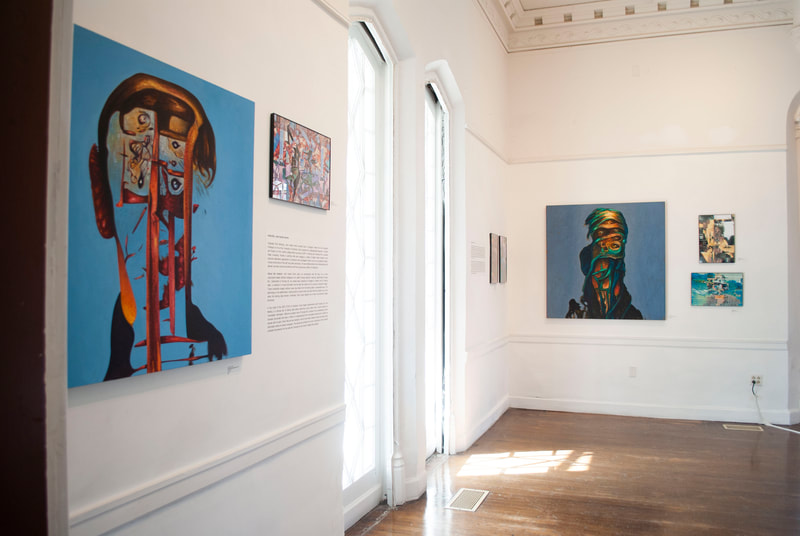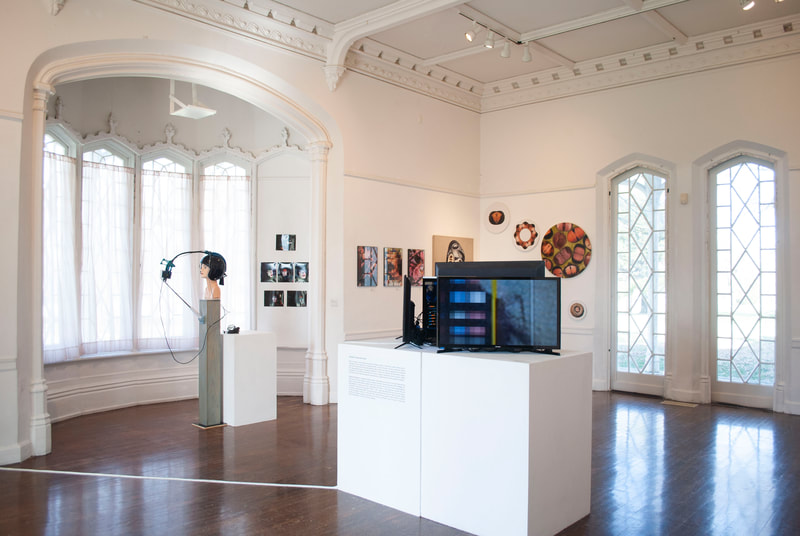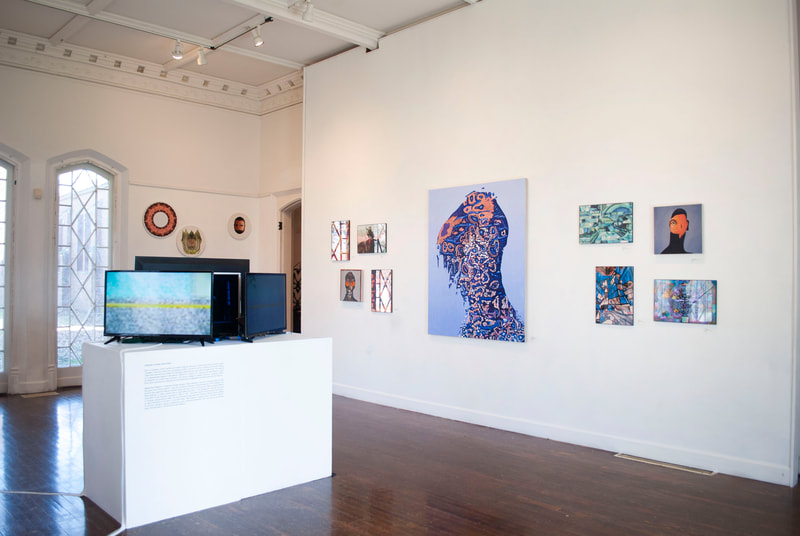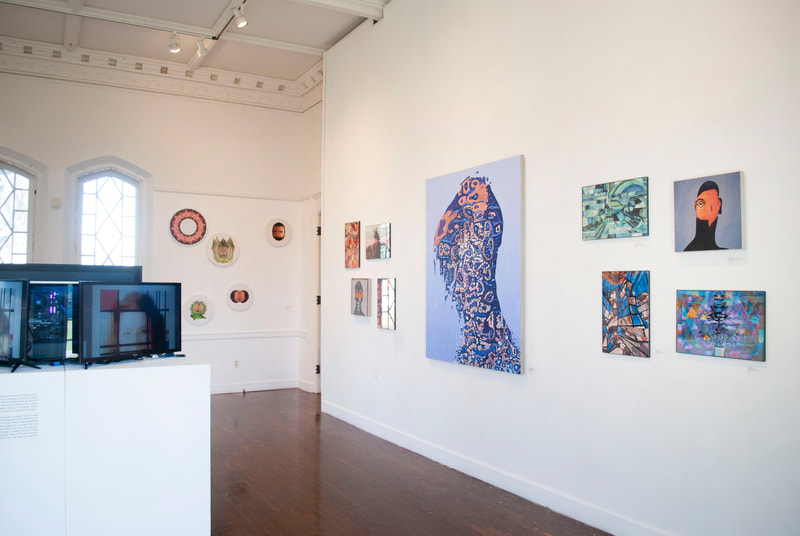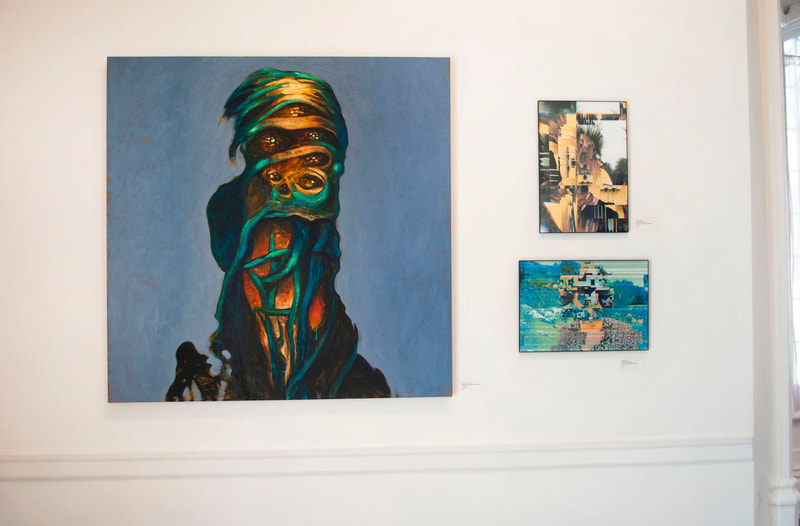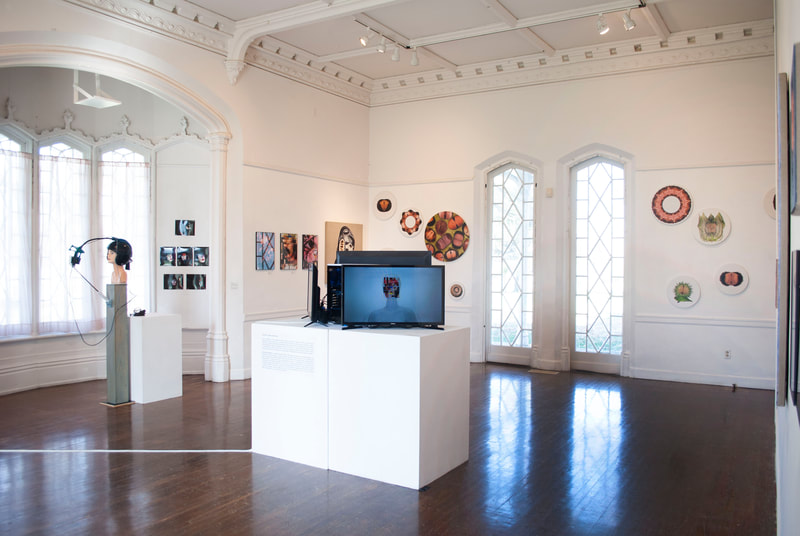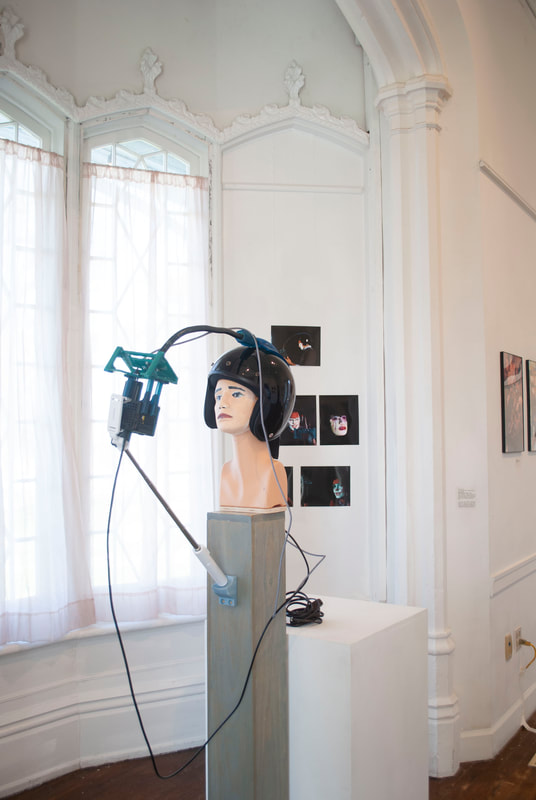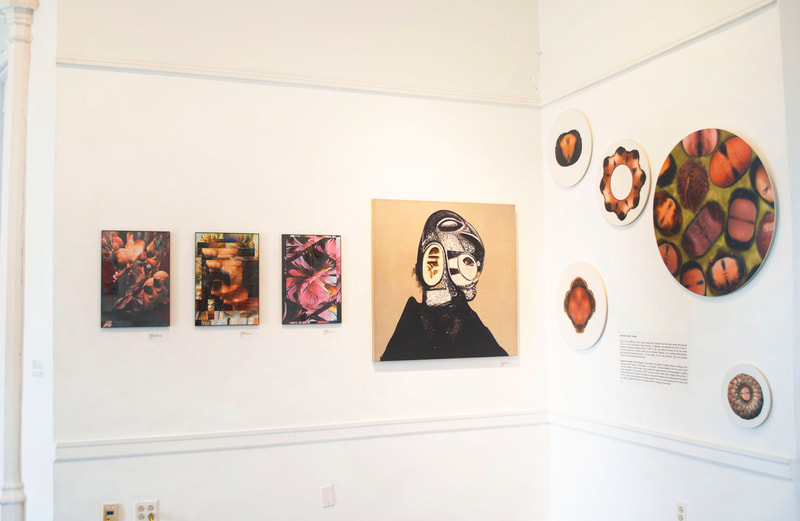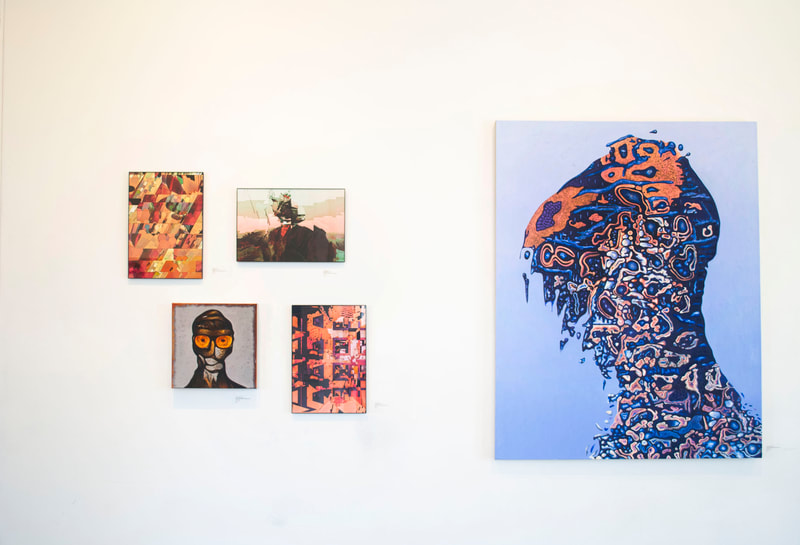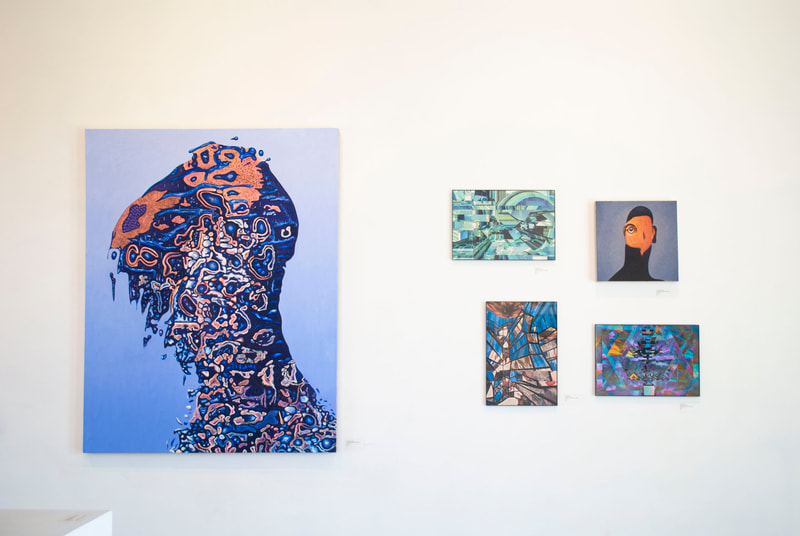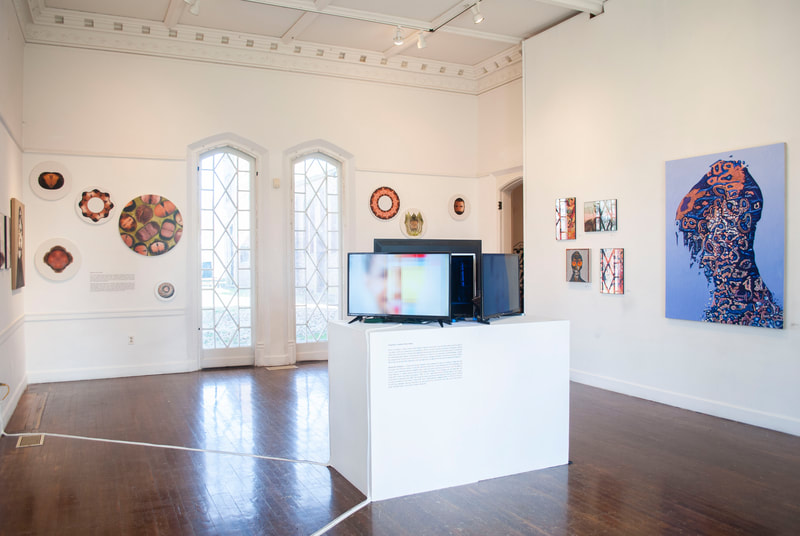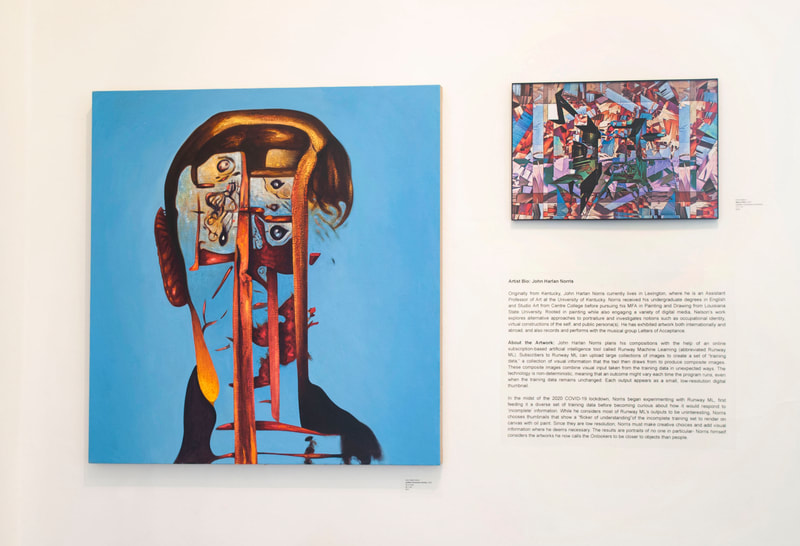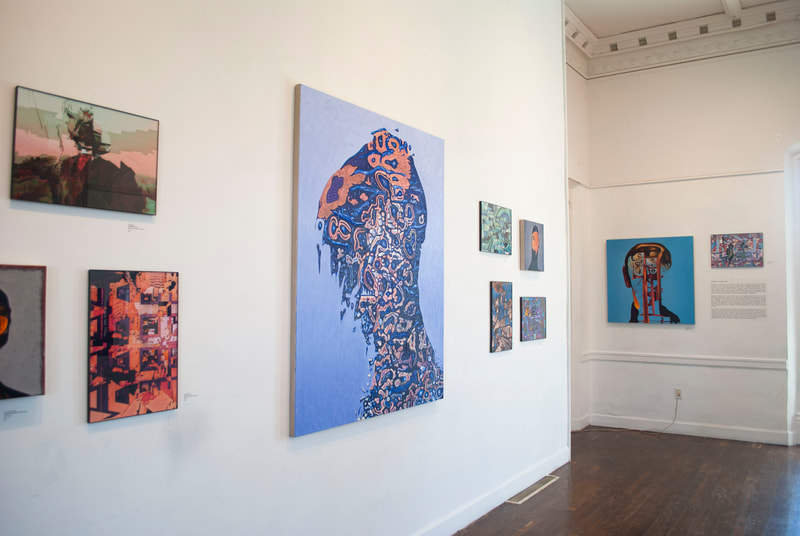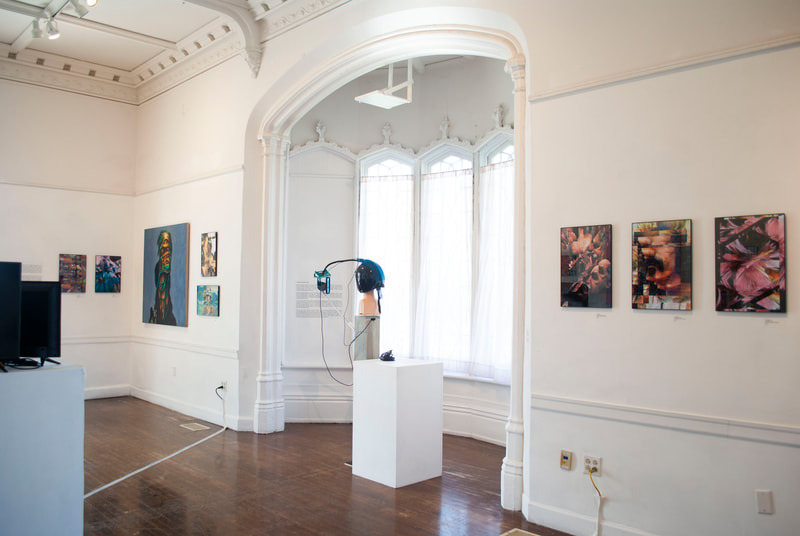Interface: Technology and Portraiture
Curated by: Sydney Mullins
As with any genre, portraiture is recognizable because of its use of specific artistic conventions. In a portrait, we expect to see a depiction of a particular person that includes their face, neck, and shoulders, and sometimes even their full body. However, the most important part of a portrait is the face as it tells you who the portrait is trying to depict. Humans recognize and perceive others based on their facial features; our faces are one of the most basic building blocks of our social bonds. Without a face, a portrait can be haunting, confusing, or feel incomplete. However, now things are more complicated as the traditional societies, relationships, group dynamics and possibilities of portraiture are expanded and reconfigured by new media and, especially, new technologies. This show explores what happens under those conditions, when an artist both ignores and plays with the conventions of portraiture. What does it mean when a portrait is of no one, or doesn’t follow a familiar set of rules? Is it still a portrait? Do we recognize it as such?
Interface: Technology and Portraiture showcases the work of five Kentucky-area artists working with digital technologies: Chris Nelson, John Harlan Norris, Siavash Tohidi, Charles Dillon Ward, and Amy M. Youngs. Each artist uses different digital tools to subvert the conventions of portraiture. Nelson and Youngs use unpredictable computer programs to alter photographs of friends and celebrities into unrecognizable shapes. Norris and Ward employ artificial intelligence and facial recognition software to generate artworks that follow the conventions of portraiture, but depict no one in particular. Tohidi employs useful applications for Augmented Reality, combining portraiture with physiology.
Each artwork featured in this exhibition plays with the rules specific to portraiture, changing the appearance of a famous celebrity, a loved one, or the self. Their goal? To stretch the limits of and critique the genre of portraiture and to question our own assumptions about its scope and function.
-Sydney Mullins, Curator
Interface: Technology and Portraiture showcases the work of five Kentucky-area artists working with digital technologies: Chris Nelson, John Harlan Norris, Siavash Tohidi, Charles Dillon Ward, and Amy M. Youngs. Each artist uses different digital tools to subvert the conventions of portraiture. Nelson and Youngs use unpredictable computer programs to alter photographs of friends and celebrities into unrecognizable shapes. Norris and Ward employ artificial intelligence and facial recognition software to generate artworks that follow the conventions of portraiture, but depict no one in particular. Tohidi employs useful applications for Augmented Reality, combining portraiture with physiology.
Each artwork featured in this exhibition plays with the rules specific to portraiture, changing the appearance of a famous celebrity, a loved one, or the self. Their goal? To stretch the limits of and critique the genre of portraiture and to question our own assumptions about its scope and function.
-Sydney Mullins, Curator
Chris Nelson
Artist Bio: Born and raised in Lexington, Kentucky, Chris Nelson currently lives in Lexington and works in retail. Nelson attended Lexington’s Tates Creek High School, where he never enrolled in a single art class. In his late teens, Nelson taught himself to play the dulcimer and bass guitar, before learning to use digital instruments and mix his own music. Nelson is now a self-taught artist as well as musician, first specializing in action and drip painting before becoming interested in computer-assisted artwork and digital portraiture. Nelson’s most recent work explores the limits of Artificial Intelligence when used to create otherworldly landscapes. Nelson celebrated his debut exhibition in November 2022 at the Pam Miller Downtown Art Center.
About the Artwork: Nelson uses a cocktail of photo-editing applications that he keeps close to his chest to achieve the patterns and colors found in his digital portraiture. He begins with a portrait photograph of a friend or celebrity found on the internet. Using filters available through apps like Canva, Instagram, and Vsco, Nelson layers filter after filter on the original photograph until it is unrecognizable as the person he started with. When asked how he selects his subjects (his body of work includes figures like Salvador Dalí, Dolly Parton, and Chaka Khan), Nelson replied that he simply chooses people who “look interesting or have interesting lives.” He then prints the final result on photo paper using an inkjet printer before framing.
John Harlan Norris
Artist Bio: Originally from Kentucky, John Harlan Norris currently lives in Lexington, where he is an Assistant Professor of Art at the University of Kentucky. Norris received his undergraduate degrees in English and Studio Art from Centre College before pursuing his MFA in Painting and Drawing from Louisiana State University. Rooted in painting while also engaging a variety of digital media, Nelson’s work explores alternative approaches to portraiture and investigates notions such as occupational identity, virtual constructions of the self, and public persona(s). He has exhibited artwork both internationally and abroad, and also records and performs with the musical group Letters of Acceptance.
About the Artwork: John Harlan Norris plans his compositions with the help of an online subscription-based artificial intelligence tool called Runway Machine Learning (abbreviated Runway ML). Subscribers to Runway ML can upload large collections of images to create a set of “training data,” a collection of visual information that the tool then draws from to produce composite images. These composite images combine visual input taken from the training data in unexpected ways. The technology is non-deterministic, meaning that an outcome might vary each time the program runs, even when the training data remains unchanged. Each output appears as a small, low-resolution digital thumbnail.
In the midst of the 2020 COVID-19 lockdown, Norris began experimenting with Runway ML, first feeding it a diverse set of training data before becoming curious about how it would respond to ‘incomplete’ information. While he considers most of Runway ML’s outputs to be uninteresting, Norris chooses thumbnails that show a “flicker of understanding”of the incomplete training set to render on canvas with oil paint. Since they are low resolution, Norris must make creative choices and add visual information where he deems necessary. The results are portraits of no one in particular- Norris himself considers the artworks he now calls the Onlookers to be closer to objects than people.
Siavash Tohidi
Artist Bio: Born and raised in Tehran, Iran, Siavash Tohidi currently lives in Lexington, Kentucky where he teaches at the University of Kentucky’s School of Art and Visual Studies. He earned his BFA in Crafts from the University of Art in Tehran, and he received his MFA in Sculpture and Expanded Practice from Ohio University School of Art+Design. He works in various media and has exhibited his work in several national and international juried shows.
About the artwork: Digital Skin/Face Paint (abbreviated DFP) was made in partnership with Dr. Daniel Lau, Dr. Michael Winkler. The project was a collaboration between the Department of Electrical and Computer Engineering, the Department of Radiology, and the School of Art and Visual Studies at the University of Kentucky. It is a wearable device designed to project images onto the wearer with a spatial augmented reality system.
The device consists of a motorbike helmet fitted with a specially-designed and posable anglerfish arm. The end of the arm houses an Intel RealSense SR300 camera that is capable of both scanning and projecting onto the wearer’s face. From a computer attached to the helmet by a USB cable, the user can use any image- typically a jpeg or png file- and project it in real-time on the wearer’s face. The specially-designed computer program cuts out spaces for the wearer’s eyes so that it does not blind them with the projector’s light.
Tohidi, Dr. Lau, and Dr. Winkler conceived of DFP for use as a medical training tool. Medical students can only learn certain routine procedures, such as intubation, by practicing on a living patient, which can be uncomfortable for the patient while the student is still learning the process. Tohidi explains that once DFP (now only a prototype) is perfected, it can be used to project different organs or systems on a transparent model of the body, and may even incorporate real-time color changes to indicate correct and incorrect techniques during a student’s training on a given procedure.
Charles Dillon Ward
Artist Bio: Born in Charlston, South Carolina and raised in Murray, Kentucky, Charles Dillon Ward currently lives in Lexington, Kentucky, where he is completing his MFA in Studio Art at the University of Kentucky. Ward’s video work explores the intimate and alienated relationship we have with the digital world. He received his undergraduate degree in Storytelling Traditions in Cinema, Art, Literature and New Media, a major he designed for himself when enrolled in the honors college at Western Kentucky University. Ward’s films have screened both nationally and internationally at independent as well as popular film festivals.
About the Artwork: In Eigenface Boogie Woogie, Ward attempts to see as a computer does through the eyes of an iPhone camera. Using the camera’s Automatic Facial Recognition (AFR) Software, the point of view searches different subjects’ faces, blurring in and out of focus as it tries to identify different facial features. A yellow square tries to encompass the faces. In the background, we hear the tune Daisy Bell, a tune originally composed in 1892. In 1961, Daisy Bell became the first song to be sung by a computer, programmed by IBM. The song has been augmented and slowed in Ward’s version, adding an eerie ambiance to the work. In this brief video, Ward playfully imagines what an iPhone is doing in its off time- perhaps copying, transforming, and combining inspirations from the work of its favorite artist, Piet Mondrian, in an act of inhuman creativity.
Amy M. Youngs
Artist Bio: Born in Chico, California, Amy M. Young moved to San Francisco in her late teens, where she received a BA in Art from San Francisco State University. On fellowship, she attended the School of the Art Institute of Chicago and earned an MFA in 1999. In 2001 she joined the faculty at the Ohio State University where she is currently working as an Associate Professor of Art, leading interdisciplinary grant projects and teaching courses in moving image, eco art, and art/science. She has exhibited artwork both nationally and internationally.
About the Artwork: Micropropagation is the science and practice of rapidly growing, multiplying, and manipulating plant tissues in Petri dishes. In her artwork, Youngs speculates how this science might look when applied to human beings. Youngs created the images featured in Micropropagation by taking digital photographs of her friends’, family's, and other artists’ heads before digitally altering them in Adobe Photoshop and Illustrator. She bisects the faces and foreheads using multiple types of symmetry found in nature, including bilateral and radial symmetry. The round, white backgrounds for these forms are meant to suggest Petri dishes or the bright view from beneath a microscope.
Artist Bio: Born and raised in Lexington, Kentucky, Chris Nelson currently lives in Lexington and works in retail. Nelson attended Lexington’s Tates Creek High School, where he never enrolled in a single art class. In his late teens, Nelson taught himself to play the dulcimer and bass guitar, before learning to use digital instruments and mix his own music. Nelson is now a self-taught artist as well as musician, first specializing in action and drip painting before becoming interested in computer-assisted artwork and digital portraiture. Nelson’s most recent work explores the limits of Artificial Intelligence when used to create otherworldly landscapes. Nelson celebrated his debut exhibition in November 2022 at the Pam Miller Downtown Art Center.
About the Artwork: Nelson uses a cocktail of photo-editing applications that he keeps close to his chest to achieve the patterns and colors found in his digital portraiture. He begins with a portrait photograph of a friend or celebrity found on the internet. Using filters available through apps like Canva, Instagram, and Vsco, Nelson layers filter after filter on the original photograph until it is unrecognizable as the person he started with. When asked how he selects his subjects (his body of work includes figures like Salvador Dalí, Dolly Parton, and Chaka Khan), Nelson replied that he simply chooses people who “look interesting or have interesting lives.” He then prints the final result on photo paper using an inkjet printer before framing.
John Harlan Norris
Artist Bio: Originally from Kentucky, John Harlan Norris currently lives in Lexington, where he is an Assistant Professor of Art at the University of Kentucky. Norris received his undergraduate degrees in English and Studio Art from Centre College before pursuing his MFA in Painting and Drawing from Louisiana State University. Rooted in painting while also engaging a variety of digital media, Nelson’s work explores alternative approaches to portraiture and investigates notions such as occupational identity, virtual constructions of the self, and public persona(s). He has exhibited artwork both internationally and abroad, and also records and performs with the musical group Letters of Acceptance.
About the Artwork: John Harlan Norris plans his compositions with the help of an online subscription-based artificial intelligence tool called Runway Machine Learning (abbreviated Runway ML). Subscribers to Runway ML can upload large collections of images to create a set of “training data,” a collection of visual information that the tool then draws from to produce composite images. These composite images combine visual input taken from the training data in unexpected ways. The technology is non-deterministic, meaning that an outcome might vary each time the program runs, even when the training data remains unchanged. Each output appears as a small, low-resolution digital thumbnail.
In the midst of the 2020 COVID-19 lockdown, Norris began experimenting with Runway ML, first feeding it a diverse set of training data before becoming curious about how it would respond to ‘incomplete’ information. While he considers most of Runway ML’s outputs to be uninteresting, Norris chooses thumbnails that show a “flicker of understanding”of the incomplete training set to render on canvas with oil paint. Since they are low resolution, Norris must make creative choices and add visual information where he deems necessary. The results are portraits of no one in particular- Norris himself considers the artworks he now calls the Onlookers to be closer to objects than people.
Siavash Tohidi
Artist Bio: Born and raised in Tehran, Iran, Siavash Tohidi currently lives in Lexington, Kentucky where he teaches at the University of Kentucky’s School of Art and Visual Studies. He earned his BFA in Crafts from the University of Art in Tehran, and he received his MFA in Sculpture and Expanded Practice from Ohio University School of Art+Design. He works in various media and has exhibited his work in several national and international juried shows.
About the artwork: Digital Skin/Face Paint (abbreviated DFP) was made in partnership with Dr. Daniel Lau, Dr. Michael Winkler. The project was a collaboration between the Department of Electrical and Computer Engineering, the Department of Radiology, and the School of Art and Visual Studies at the University of Kentucky. It is a wearable device designed to project images onto the wearer with a spatial augmented reality system.
The device consists of a motorbike helmet fitted with a specially-designed and posable anglerfish arm. The end of the arm houses an Intel RealSense SR300 camera that is capable of both scanning and projecting onto the wearer’s face. From a computer attached to the helmet by a USB cable, the user can use any image- typically a jpeg or png file- and project it in real-time on the wearer’s face. The specially-designed computer program cuts out spaces for the wearer’s eyes so that it does not blind them with the projector’s light.
Tohidi, Dr. Lau, and Dr. Winkler conceived of DFP for use as a medical training tool. Medical students can only learn certain routine procedures, such as intubation, by practicing on a living patient, which can be uncomfortable for the patient while the student is still learning the process. Tohidi explains that once DFP (now only a prototype) is perfected, it can be used to project different organs or systems on a transparent model of the body, and may even incorporate real-time color changes to indicate correct and incorrect techniques during a student’s training on a given procedure.
Charles Dillon Ward
Artist Bio: Born in Charlston, South Carolina and raised in Murray, Kentucky, Charles Dillon Ward currently lives in Lexington, Kentucky, where he is completing his MFA in Studio Art at the University of Kentucky. Ward’s video work explores the intimate and alienated relationship we have with the digital world. He received his undergraduate degree in Storytelling Traditions in Cinema, Art, Literature and New Media, a major he designed for himself when enrolled in the honors college at Western Kentucky University. Ward’s films have screened both nationally and internationally at independent as well as popular film festivals.
About the Artwork: In Eigenface Boogie Woogie, Ward attempts to see as a computer does through the eyes of an iPhone camera. Using the camera’s Automatic Facial Recognition (AFR) Software, the point of view searches different subjects’ faces, blurring in and out of focus as it tries to identify different facial features. A yellow square tries to encompass the faces. In the background, we hear the tune Daisy Bell, a tune originally composed in 1892. In 1961, Daisy Bell became the first song to be sung by a computer, programmed by IBM. The song has been augmented and slowed in Ward’s version, adding an eerie ambiance to the work. In this brief video, Ward playfully imagines what an iPhone is doing in its off time- perhaps copying, transforming, and combining inspirations from the work of its favorite artist, Piet Mondrian, in an act of inhuman creativity.
Amy M. Youngs
Artist Bio: Born in Chico, California, Amy M. Young moved to San Francisco in her late teens, where she received a BA in Art from San Francisco State University. On fellowship, she attended the School of the Art Institute of Chicago and earned an MFA in 1999. In 2001 she joined the faculty at the Ohio State University where she is currently working as an Associate Professor of Art, leading interdisciplinary grant projects and teaching courses in moving image, eco art, and art/science. She has exhibited artwork both nationally and internationally.
About the Artwork: Micropropagation is the science and practice of rapidly growing, multiplying, and manipulating plant tissues in Petri dishes. In her artwork, Youngs speculates how this science might look when applied to human beings. Youngs created the images featured in Micropropagation by taking digital photographs of her friends’, family's, and other artists’ heads before digitally altering them in Adobe Photoshop and Illustrator. She bisects the faces and foreheads using multiple types of symmetry found in nature, including bilateral and radial symmetry. The round, white backgrounds for these forms are meant to suggest Petri dishes or the bright view from beneath a microscope.
|
Public Gallery Hours
Wednesday 12pm-5pm
Thursday 12pm-5pm Friday 12pm-5pm Saturday 12pm - 5pm Viewings also available by appointment |
The Loudoun House
209 Castlewood Dr. Lexington, Ky. 40505 Email: [email protected]
Phone 859-254-7024 |
|
All Lexington Art League programs are made possible through the generous support of LexArts.
|
The Kentucky Arts Council, a state arts agency, provides operating support to the Lexington Art League with state tax dollars and federal funding from the National Endowment for the Arts. Additional support provided by Lexington Parks & Recreation.
|


